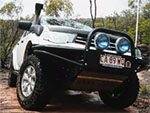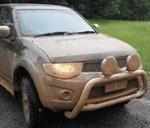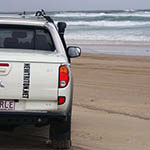Hi All
I am currently on a round oz trip towing a 2650 kg van.
The Turbo operates at different times and revs, and I simply would like to know
if anyone knows the logic of operation of the turbo.
Is it:
A: Always comes on according to engine revs.(with a upper lower limit)
B: As in A: but gear dependant
C: Based on Engine load / torque
D: Combination of the above
E: None of the above.
Have recently bought a BlueTooth Engine monitor plugin, but trying to get my head around
the best driving technique first for best fuel consumption.
On the flat I can often go into overdrive and the Engine doesn't seem to labour. As soon as
I feel it is anywhere near labouring, I click OD off. Similarly I will stay with OD off when the speed
is less then 90km/hr.
However, the Turbo cycling seems to interupt my driving pattern.
Regards
Turbo, sequence of operation
7 posts
• Page 1 of 1
Re: Turbo, sequence of operation
The way I understand it is a turbo will always kick in at a set RPM regardless of load. You 4x4 will usually make better economy driving on boost, than just below or above boost - which means it may be better to use a lower gear towing to keep the revs at the right range. Than sitting in a higher gear at the point where the boost is yet to start building up (for example 1800rpm or so vs lower gear and 2300rpm).
-

macca002 - Posts: 1334
- Joined: Thu May 16, 2013 5:58 pm
- Location: Darwin, NT
Re: Turbo, sequence of operation
What model Triton do you have,
Some models have the VGT turbo and some dont,
Some models have the VGT turbo and some dont,
-

Lee-thal - Posts: 899
- Joined: Thu Jul 15, 2010 8:28 am
Re: Turbo, sequence of operation
I dont know if turbo diesels are different but as far as I'm aware the engine needs to be spinning at enough RPM to start spinning the turbo fast enough to generate pressure how much pressure it generates and how quickly depends on the load on it but it does need to be spinning fast enough in the first place. Once you are over this RPM then the boost will build and fall depending on the load on it, the revs and how much right boot you are applying, the higher in the revs you are usually the quicker it will build the boost back up (if you back off then accelerate again) just because the turbo is spinning faster.
Once the turbo gets to the wastegate pressure it will vent excess pressure that would send it above the pressure set on the wastegate.
The way your are driving sounds ok to me, most recommendations suggest avoiding the engine laboring is the best for fuel economy and the car in general and the fuel is only going in at the rate you are pressing down the throttle (more or less, its a bit more complicated with drive by wire) so if you have to use less throttle in the lower gear (od off) then you are using less fuel
Once the turbo gets to the wastegate pressure it will vent excess pressure that would send it above the pressure set on the wastegate.
The way your are driving sounds ok to me, most recommendations suggest avoiding the engine laboring is the best for fuel economy and the car in general and the fuel is only going in at the rate you are pressing down the throttle (more or less, its a bit more complicated with drive by wire) so if you have to use less throttle in the lower gear (od off) then you are using less fuel
-

Sootie - Posts: 314
- Joined: Wed Mar 27, 2013 2:23 pm
Re: Turbo, sequence of operation
Lee-thal wrote:What model Triton do you have,
Some models have the VGT turbo and some dont,
shed indicates 2011 auto.
"it's so much easier to apologise rather than ask for permission" - gutters
The Cattle Truck
"Wool-Wheat" = Cotton. Warm like wool, but grows like wheat
-

helicoptercow - Platinum Subscriber
- Posts: 1869
- Joined: Fri Jun 04, 2010 4:01 pm
- Location: Medowie, Newcastle
Re: Turbo, sequence of operation
I would also like to know I have a MN 2010 MY12 with VGT
at what point do the vanes fully open and close ? or is it varied on the amount of throttle given as opposed to revs?
at what point do the vanes fully open and close ? or is it varied on the amount of throttle given as opposed to revs?
- adamace
- Posts: 37
- Joined: Mon Apr 09, 2012 1:09 pm
Re: Turbo, sequence of operation
Boost produced by the turbo is dependant upon the volume of exhaust gasses emitted by the engine. Therefore the answer is sort of a combination of those factors. It requires enough revs, but also enough fuel being burnt.
You can have it roving at 4000 rpm, but no throttle input (as in engine braking on a steep decent) therefore no fuel, negligible exhaust emitted.
Alternatively, you could be at 1200 rpm and full throttle, but not enough volume of exhaust to spin the turbine and make boost.
You can have it roving at 4000 rpm, but no throttle input (as in engine braking on a steep decent) therefore no fuel, negligible exhaust emitted.
Alternatively, you could be at 1200 rpm and full throttle, but not enough volume of exhaust to spin the turbine and make boost.
-

Froggy - Posts: 1372
- Joined: Sun Jan 30, 2011 4:19 pm
- Location: Springfield Lakes, QLD
7 posts
• Page 1 of 1
Who is online
Users browsing this forum: No registered users and 6 guests

